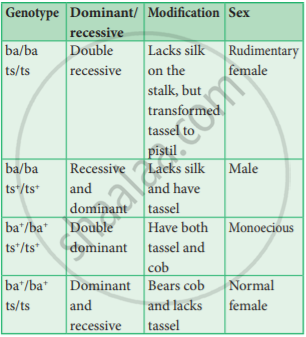Advertisements
Advertisements
प्रश्न
How sex is determined in monoecious plants. write their genes involved in it.
उत्तर
Zea mays (maize) is an example of monoecious, which means male and female flowers are present on the same plant. There are two types of inflorescence. The terminal inflorescence bears staminate florets that develop from shoot apical meristem called the tassel. The lateral inflorescence which develops pistillate florets from the axillary bud is called ear or cob. Unisexuality in maize occurs through the selective abortion of stamens in-ear florets and pistils in tassel florets. Substitution of two single gene pairs ‘ba’ for barren plant and ‘ts’ for tassel
the seed makes the difference between monoecious and dioecious (rare)

Sex determination in Maize (Superscript (+) denotes dominant character)
maize plants. The allele for barren plant (ba) when homozygous makes the stalk staminate by eliminating silk and ears. The allele for tassel seed
(ts) transforms tassel into a pistillate structure that produces no pollen. The table is the resultant sex expression ‘ based on the combination of these
alleles. Most of these mutations are shown to be defects in gibberellin biosynthesis. Gibberellins play an important role in the suppression of stamens in florets on the ears.
